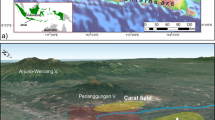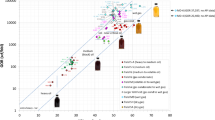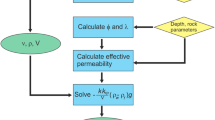Abstract
PHYSICO-CHEMICAL processes that increase coal rank also increase vitrinite reflectance, or the level of vitrinite diagenesis. The principal physical factors controlling these processes have been identified as geothermal gradient, thermal conductivity of lithological section, duration of heating, and pressure1,2. Interaction of these factors on coalification has not been demonstrated conclusively in nature or by laboratory experiments, but temperature and time have been generally regarded3 as most influential. Although the retarding effect of pressure has been widely recognised, the role of pressure is not clearly understood and has been considered3 negligible. Here the same values of mean vitrinite reflectance in oil (Rmo%) have been related to present temperature, (T), and to a function of the present temperature and the ratio of the gradients of normal hydrostatic pressure (PNH) and observed pore pressure (PP), T(γPNH/γPp), in Fig. 1a and b respectively. Comparison of correlation coefficients of Fig. 1a and b demonstrates that, for values of Rmo less than 1.50%, retardation of vitrinite diagenesis by abnormally high formation pressure, is both significant and predictable. As a corollary, the time factor seems to be of limited significance on a geological scale.
This is a preview of subscription content, access via your institution
Access options
Subscribe to this journal
Receive 51 print issues and online access
$199.00 per year
only $3.90 per issue
Buy this article
- Purchase on Springer Link
- Instant access to full article PDF
Prices may be subject to local taxes which are calculated during checkout
Similar content being viewed by others
References
Teichmüller, M. & Teichmüller, R. in Coal and Coal-bearing Strata (eds Murchison, D. G. & Westcoll, T. S.) 233–267 (Oliver and Boyd, Edinburgh, 1968).
Ammosov, I. I. C.R. 6ème Congres Int. Strat. Geol. Carbonifère 2, 403–415 (1970).
Lopatin, N. V. & Bostick, N. H. Reprint Ill. Geol. Surv. 1974–Q, 1–16 (1974).
Gretener, P. E. Bull. Can. petrol. Geol. 17, 255–259 (1969).
Timko, D. J., Fons, L. C., Grittman, W. K. & Rees, F. B. in Abnormal Subsurface Pressure, A Study Group Report 1969–1971, 20–30 (Houston Geological Society, Houston, 1971).
Fertl, W. H. Abnormal Formation Pressures (Elsevier, Amsterdam, 1976).
Hottman, C. E. & Johnson, R. K. J. petrol. Technol. 17, 717–723 (1965).
Wichmann, P. A. Trans. III Europ. Form. Eval. Symp. S1–S15 (1974).
Dowdle, W. L. & Cobb, W. M. J. petrol. Technol. 27, 1326–1330 (1975).
Jones, P. H. J. petrol. Technol. 21, 803–810 (1969).
Lewis, C. R. & Rose, S. C. J. petrol. Technol. 22, 11–16 (1970).
Author information
Authors and Affiliations
Rights and permissions
About this article
Cite this article
MCTAVISH, R. Pressure retardation of vitrinite diagenesis, offshore north-west Europe. Nature 271, 648–650 (1978). https://doi.org/10.1038/271648a0
Received:
Accepted:
Issue Date:
DOI: https://doi.org/10.1038/271648a0
This article is cited by
-
Geological conditions favourable for high-wax oil enrichment in Damintun depression, Bohai Bay basin
Journal of Earth Science (2009)
-
Overpressure development and oil charging in the central Junggar Basin, Northwest China: Implication for petroleum exploration
Science in China Series D: Earth Sciences (2009)
-
“Compression dynamometamorphic solid bitmen” and its significance in oil and gas exploration
Wuhan University Journal of Natural Sciences (2000)
Comments
By submitting a comment you agree to abide by our Terms and Community Guidelines. If you find something abusive or that does not comply with our terms or guidelines please flag it as inappropriate.



